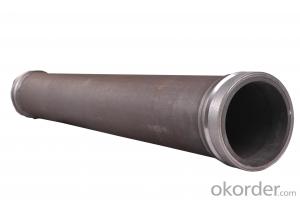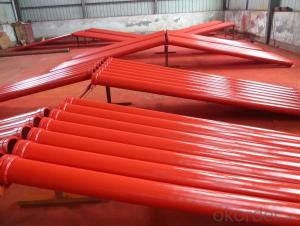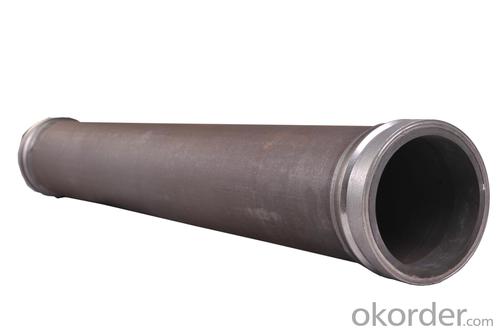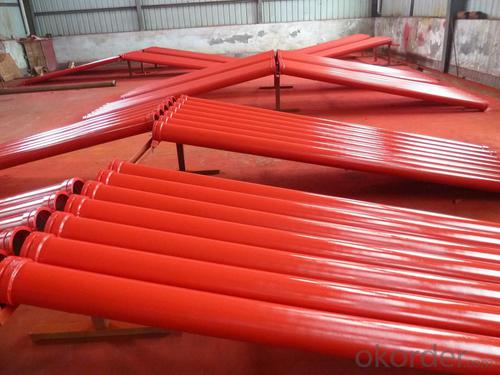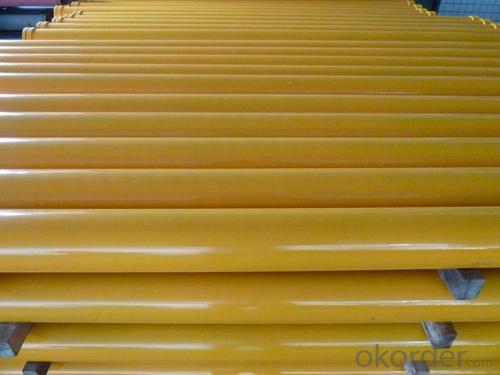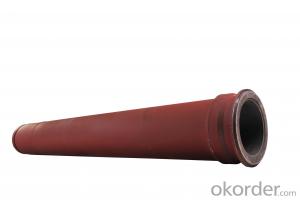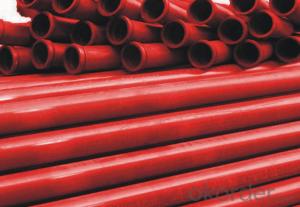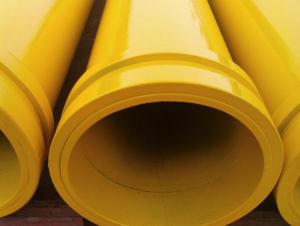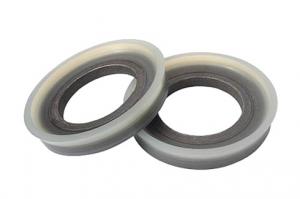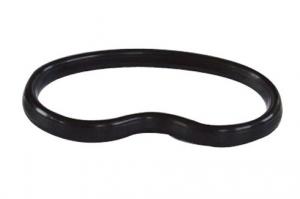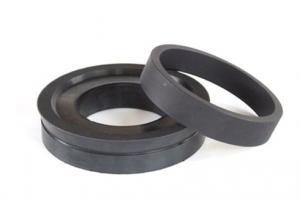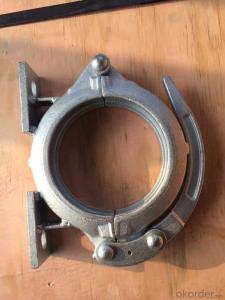Twin Wall Pipe for Concrete Pump Pipe Thickness 7mm Length 3000mm
- Loading Port:
- Tianjin
- Payment Terms:
- TT or LC
- Min Order Qty:
- 50 pc
- Supply Capability:
- 2000 pc/month
OKorder Service Pledge
OKorder Financial Service
You Might Also Like
Product Description:
Product Name: Twin Wall Pipe for Concrete Pump Pipe Thickness 7mm Length 3000mm
Specification
Diameter: DN125
Wall thickness: inner wall is 4 mm 65Mn, outer wall is 3mm seamless steel
Length: 3000&2000&1000mm with wear resistant SK flange
Type: Double / twin wall
Hardness: HRC 63
Using life: 60,000-100,000(CBM)
Highlights: longest using life
Welding: Smooth welding between straight pipes and flanges
Color : as customer's requirement,usually bule or red
Surface: Electrostatic Spraying Epoxy Paint
3. Application
Concrete delivery.
4. Package
Put into containers.
FAQ:
Q1: Why buy Materials & Equipment from OKorder.com?
A1: All products have its ISO certifications, adheres to the highest standards and a commitment to supply chain safety and customer satisfaction.
Q2: How do we guarantee the quality of our products?
A2: We have established an advanced quality management system which conducts strict quality tests at every step, from raw materials to the final product. At the same time, we provide extensive follow-up service assurances as required.
Q3: How soon can we receive the product after purchase?
A3: Within three days of placing an order, we will begin production. The specific shipping date is dependent upon international and government factors, but is typically 10 to 30 workdays.
Q4: If we can produce Twin Wall Pipe for Concrete Pump Pipe according to customers request?
A4: Yes, we can produce Twin Wall Pipe for Concrete Pump Pipe according to the difference country situations to make it suitable to the market and customers. We have very professional technical team to make the design.
Q5: How to make a quick resolution for after service?
A5: We have overseas branches all-around of world, If needed, the seller shall dispatch 2 engineers to the buyer's site for supervision of training. The buyer shall make available of necessary facilities &skilled personnel at site for training.
Images:


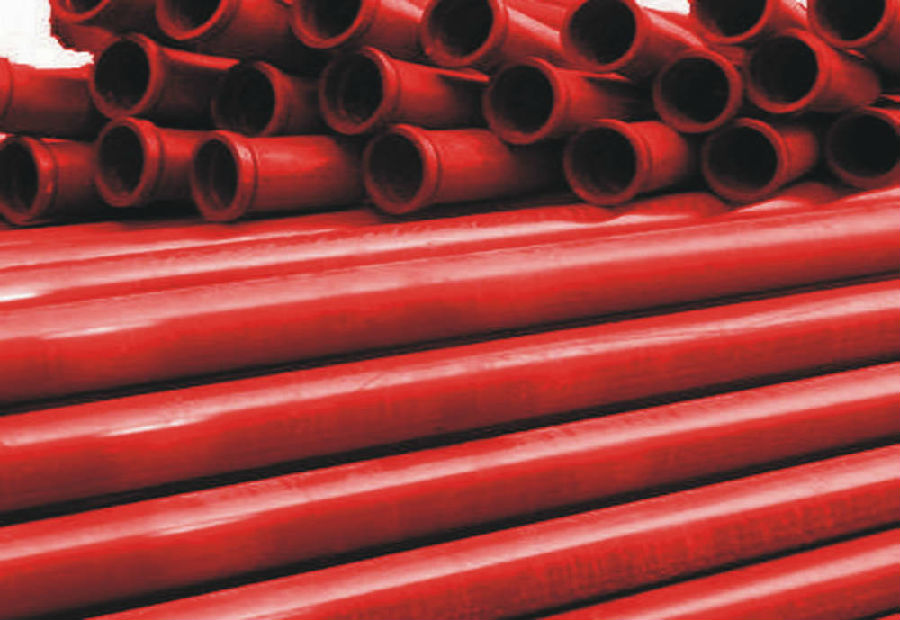
- Q: What is the purpose of a concrete pump agitator motor?
- The purpose of a concrete pump agitator motor is to ensure the consistency and quality of the concrete mixture being pumped. It is responsible for keeping the concrete mixture well-mixed and preventing it from settling or separating during the pumping process. The agitator motor helps to maintain a uniform and homogenous mixture, which is crucial for achieving strong and durable concrete structures. By continuously agitating the concrete inside the pump, the motor helps to prevent any blockages or clogs that could potentially disrupt the pumping operation. Overall, the purpose of a concrete pump agitator motor is to enhance the efficiency and effectiveness of the concrete pumping process, ultimately resulting in better construction outcomes.
- Q: What is the concrete delivery pump?
- The utility model relates to a machine for continuously conveying concrete along a pipeline by utilizing pressure, which is mainly used for building, bridges and tunnels
- Q: How often should concrete pump pistons be replaced?
- The replacement frequency for concrete pump pistons depends on several factors, including usage, maintenance, and piston quality. It is generally advised to regularly inspect the pistons for signs of wear and tear, such as cracks, pitting, or scoring. If any of these signs are detected, it is recommended to replace the pistons immediately to prevent potential failures or leaks. Concrete pump pistons typically last between 25,000 and 75,000 cubic yards of pumped concrete, although this can vary depending on specific conditions and operating practices. For example, if the concrete being pumped contains abrasive materials or if the pump is used intensively or under harsh conditions, the pistons may wear out more quickly. Furthermore, proper maintenance practices can prolong the lifespan of the pistons. This includes regular cleaning and lubrication, maintaining the pump in good condition, and ensuring the pistons are correctly aligned and not subjected to excessive pressure or stress. In conclusion, closely monitoring the condition of the pistons and referring to the manufacturer's recommendations or seeking advice from a professional is essential to determine the appropriate replacement interval for the specific concrete pump being utilized.
- Q: What are the different sizes of concrete pump pipes available?
- The sizes of concrete pump pipes available vary depending on the specific needs and requirements of the construction project. Typically, concrete pump pipes come in sizes ranging from 2 inches to 6 inches in diameter. The most commonly used sizes are 2 inches, 3 inches, 4 inches, and 5 inches. The choice of pipe size depends on factors such as the volume and pressure of the concrete being pumped, the distance the concrete needs to travel, and the type of equipment being used. Smaller diameter pipes are suitable for shorter distances and lower volumes of concrete, while larger diameter pipes are used for longer distances and higher volumes. It is important to select the appropriate pipe size to ensure efficient and safe concrete pumping. Using the correct size of pipe helps to minimize pressure loss, maintain a consistent flow rate, and prevent blockages or clogs in the system. Consulting with a concrete pumping professional or engineer is recommended to determine the most suitable pipe size for a specific construction project.
- Q: How can one determine the correct pressure and flow rating for hydraulic components in concrete pump spare parts?
- To determine the correct pressure and flow rating for hydraulic components in concrete pump spare parts, several factors need to be considered: 1. Manufacturer's specifications: Review the manufacturer's specifications for the hydraulic components. The specifications should include the recommended pressure and flow ratings for optimum performance and durability. 2. System requirements: Assess the specific requirements of the concrete pump system. Consider factors such as the size of the pump, the volume and distance of concrete being pumped, and the speed at which the concrete needs to be delivered. These factors will help determine the required pressure and flow rating for the hydraulic components. 3. Safety considerations: Ensure that the pressure and flow rating of the hydraulic components are within the safe operating limits of the concrete pump system. Exceeding these limits can lead to equipment failure, accidents, or damage to the components. 4. Compatibility: Verify that the hydraulic components are compatible with the rest of the system. The pressure and flow rating should match the capabilities and specifications of other components such as the pump, valves, and hoses to ensure proper functionality and performance. 5. Consultation with experts: If unsure about the appropriate pressure and flow rating for hydraulic components, consult with hydraulic system experts or the manufacturer's technical support team. They can provide guidance based on their expertise and experience with similar systems. It is important to note that the pressure and flow rating of hydraulic components may vary depending on the specific model, design, and intended application. Therefore, it is crucial to refer to the manufacturer's guidelines and recommendations to ensure accurate determination of the correct pressure and flow rating for hydraulic components in concrete pump spare parts.
- Q: How can a faulty concrete pump S valve affect the concrete flow?
- A faulty concrete pump S valve can affect the concrete flow by causing disruptions, blockages, or uneven distribution of the concrete. The S valve is responsible for controlling the direction of the concrete flow, and when it malfunctions, it can lead to decreased or inconsistent flow rates. This can result in delays in the construction process, poor concrete quality, or even damage to the pump system.
- Q: How does a hopper agitator blade ensure smooth concrete flow?
- To guarantee a seamless flow of concrete, a hopper agitator blade is employed to mix and disintegrate any clumps or air pockets in the concrete mixture. Specifically designed to be positioned inside the hopper, the blade rotates and agitates the concrete, ensuring a homogeneous and steady state. While in rotation, the blade disperses any settled aggregates at the hopper's base, preventing blockages or uneven distribution during the pouring procedure. This uninterrupted mixing action guarantees that the concrete remains well-blended and effortlessly pours out of the hopper. Furthermore, the agitator blade aids in breaking up any air bubbles that may have formed within the concrete mixture. These air bubbles can compromise the structural integrity of the concrete and lead to an uneven final appearance. By agitating the concrete, the blade effectively releases trapped air, promoting a consistently dense mixture. In essence, a hopper agitator blade guarantees a seamless flow of concrete by effectively blending the mixture, breaking apart any clumps or air pockets, and fostering a uniform composition. This ensures that the concrete pours smoothly and evenly during the pouring process, resulting in a top-notch end product.
- Q: How can one determine the correct voltage and current rating for electrical components in concrete pump spare parts?
- To determine the correct voltage and current rating for electrical components in concrete pump spare parts, several factors need to be considered. Firstly, it is essential to consult the manufacturer's specifications and documentation for the concrete pump and its spare parts. These documents usually provide detailed information about the voltage and current requirements for each electrical component. Paying close attention to these guidelines ensures that the components are operated within their designed parameters. Secondly, it is crucial to understand the electrical system and its requirements. This involves analyzing the power supply available at the site where the concrete pump will be used. Factors such as the voltage level (e.g., 110V, 220V, 440V) and frequency (e.g., 50Hz, 60Hz) of the electrical supply need to be taken into account. Additionally, the maximum current capacity of the electrical system must be considered to prevent overload situations. Furthermore, it is advisable to assess the specific application and operating conditions of the concrete pump. Different components may have varying voltage and current requirements depending on their function and the environment in which they are used. For instance, components installed in outdoor areas may require higher voltage ratings to withstand harsh weather conditions. Lastly, seeking professional assistance from qualified electricians or engineers is highly recommended. They possess the expertise and knowledge to accurately determine the voltage and current ratings for electrical components in concrete pump spare parts. Their experience allows them to consider various factors such as safety regulations, compatibility with the existing electrical system, and any specific requirements of the concrete pump manufacturer. By taking into account the manufacturer's specifications, understanding the electrical system, considering the application and operating conditions, and seeking professional advice, one can effectively determine the correct voltage and current rating for electrical components in concrete pump spare parts.
- Q: How can a faulty battery affect the operation of the pump?
- A faulty battery can affect the operation of the pump by causing it to lose power or stop working altogether.
- Q: What are the advantages of using OEM (Original Equipment Manufacturer) concrete pump spare parts?
- Using OEM (Original Equipment Manufacturer) concrete pump spare parts offers several benefits: 1. Quality Assurance: OEM spare parts are made by the same company that produces the original equipment, ensuring that they meet the same high-quality standards as the original components. By using OEM parts, the concrete pump will perform optimally with minimal risk of breakdowns or failures. 2. Compatibility: OEM spare parts are specifically designed to fit perfectly with the original equipment. They are built to exact specifications and dimensions, allowing for seamless integration with the concrete pump. This compatibility ensures proper and efficient functioning of the parts. 3. Reliability: OEM spare parts undergo extensive testing by the manufacturer to ensure their reliability and durability. This reduces the likelihood of premature failure or wear, resulting in reduced downtime and maintenance costs. The reliability of OEM parts also minimizes the risk of accidents or injuries caused by faulty equipment. 4. Warranty Coverage: Many OEM spare parts come with a manufacturer warranty, providing protection against defects or failures. This warranty gives customers peace of mind and assurance that they are investing in high-quality components. In case of any issues, the manufacturer typically provides support and assistance. 5. Technical Support: OEM manufacturers usually offer technical support and assistance to customers using their spare parts. This support is invaluable for troubleshooting issues, providing guidance on installation or maintenance, and optimizing the performance of the concrete pump. Non-OEM parts may not offer the same level of support. 6. Long-Term Cost Savings: While OEM spare parts may have a higher upfront cost compared to non-OEM alternatives, they often prove to be more cost-effective in the long run. Their superior quality and reliability result in fewer breakdowns, reduced maintenance expenses, and extended equipment lifespan. Using OEM parts also helps maintain the resale value of the concrete pump. In conclusion, the advantages of using OEM concrete pump spare parts include quality assurance, compatibility, reliability, warranty coverage, technical support, and long-term cost savings. By choosing OEM parts, users can ensure smooth and efficient operation of their concrete pump while minimizing risks and maximizing their investment's return.
Send your message to us
Twin Wall Pipe for Concrete Pump Pipe Thickness 7mm Length 3000mm
- Loading Port:
- Tianjin
- Payment Terms:
- TT or LC
- Min Order Qty:
- 50 pc
- Supply Capability:
- 2000 pc/month
OKorder Service Pledge
OKorder Financial Service
Similar products
Hot products
Hot Searches
Related keywords
